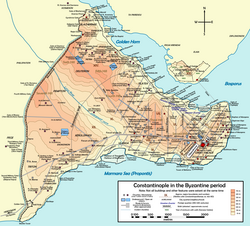Cistern of Mocius
[2] The cistern is located in Istanbul, in the district of Fatih (the walled city), in the quarter of Altımermer and the mahalle of Seyyid Ömer, to the northeast of the Seyyid Ömer Mosque, between Ziya Gökalp Sokak to the north and Cevdet Paşa Caddesi to the south.
[2] The name came from the important church dedicated to Saint Mocius, which was located near the southwest corner of the reservoir.
[4] Writing after the Ottoman conquest of 1453, the 16th-century French traveler Pierre Gilles observed that around 1540 the reservoir was empty.
As of 2014 the area is used as "Educational Park" (Turkish: Fındıkzade Eğitim parkı) of the Fatih district.
Its walls, 6.00 metres (19.69 ft) thick[1] and partially still in place,[3] were built using the Roman construction technique opus listatum, by alternating courses of bricks and of stone,[5] an elegant pattern similar to that also used by the similar cisterns of Aetius and of Aspar.

